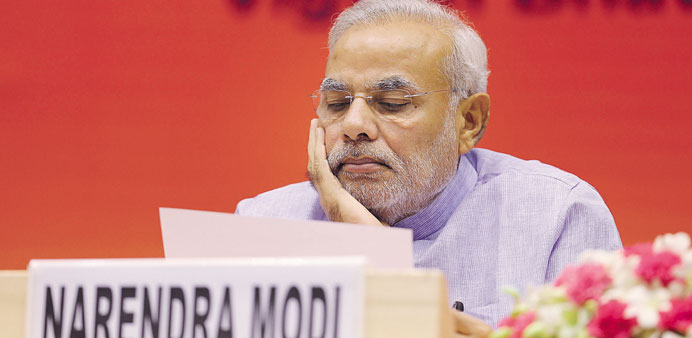Modi: his exalted position has received a glancing blow from his party’s failure to perform up to expectations in the by-elections.
A month after assuming office, Narendra Modi had rued the absence in his case of the customary honeymoon period for a new prime minister. Now, the by-election setbacks and signs of dissonance at the top have cast a further shadow on his first 100 days as prime minister.
The sombre mood was not quite what he might have expected at the start of his tenure. The prime minister and his party were then on a roll, having achieved what they could not have imagined in their wildest dreams before the general election - an absolute majority in parliament.
Modi’s stature was at its zenith then, as was exemplified by his sitting on a throne-like chair on a platform to address the ministers and party men sitting some distance away at a lower level.
That his word was law was also evident from the fact that his approval was necessary even for the selection of staff by the ministers.
Now, Modi’s exalted position has received a glancing blow from the BJP’s failure to perform up to expectations in the by-elections. And the evidence of a rift between Home Minister Rajnath Singh and another as yet unnamed senior minister has dented the government’s image.
To what extent these intimations of political mortality will cramp the prim minister’s style is not known. In all likelihood, it will make him all the more aware of the need to push ahead with greater vigour on both the administrative and political fronts
There is little doubt that the perception that he is not living up to his reputation as a doer is partly responsible for the marginal slide in the Bharatiya Janata Party’s (BJP’s) electoral position.
As of now, there is little to show for his presence at the helm. The generally upbeat mood in the share markets is based more on the expectations of “achhe din” (good days) than on reality.
There has been no ostensible flow of foreign investment or of a surge in developmental activity such as the construction of roads and bridges.
All that is palpable so far is a plethora of promises, whether it is bullet trains or e-governance or smart cities or bank account-based debit cards for the poor or toilets in schools and for women.
Admittedly, it is acknowledged that all these programmes will take time to be implemented. But the flip side of today’s so-called aspirational generation is that their patience is seemingly limited.
Unless there are visible signs of progress, the young appear to lose interest.
This is what seems to have happened in the electoral arena, suggesting that Modi’s spin doctors may have overplayed the hype over the coming “good days”. Their exaggeration appears to have now boomeranged.
It is also undeniable that the government has been hurt more by the words and deeds of its friends than its foes. While the latter had been in a state of demoralisation until their spirits were revived by the recent by-poll results, there are people in the saffron camp like Rashtriya Swayamsevak Sangh (RSS)chief Mohan Bhagwat and the BJP gadfly, Subramanian Swamy, who have harmed the government’s credibility with their uninhibited espousal of the Hindu agenda.
Arguably, the communal polarisation caused by Bhagwat’s assertion that India is a Hindu nation, and Swamy’s letter to the PM on building the Ram temple helped parties like the Congress in Karnataka and the Rashtriya Janata Dal (RJD)-Janata Dal (United) combine in Bihar to strengthen their Muslim base of support in the by-elections.
In addition, the anti-English stance of an outfit like the Angrezi Virodhi Manch, which intends to do away with English all over the country, cannot but reinforce the BJP’s image of being a party of rustic, blinkered elements in what is known as the cow belt, which is the derogatory term for the Hindi heartland used by those who do not live there.
*Amulya Ganguli, a political analyst, can be reached at [email protected]



